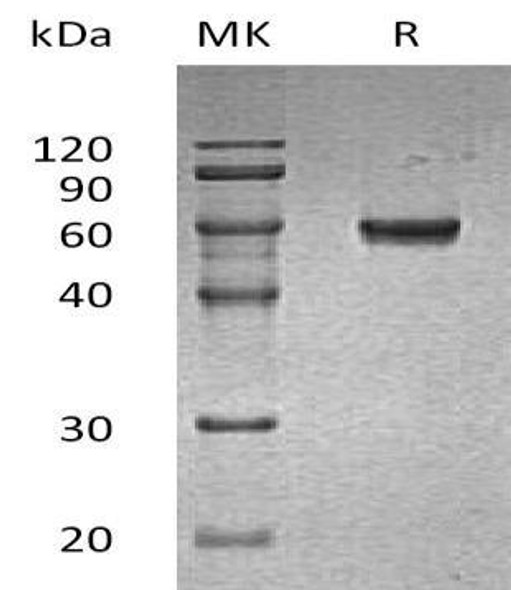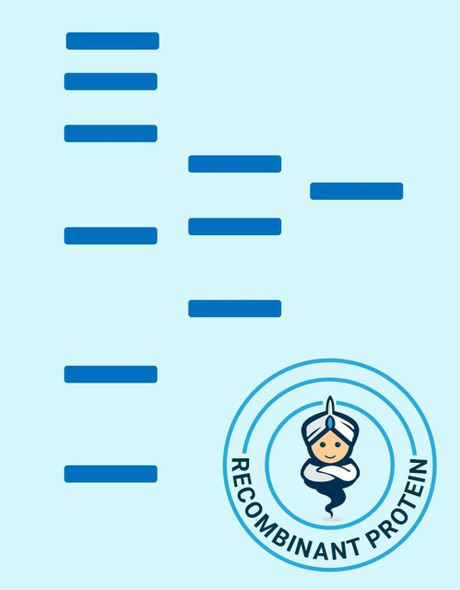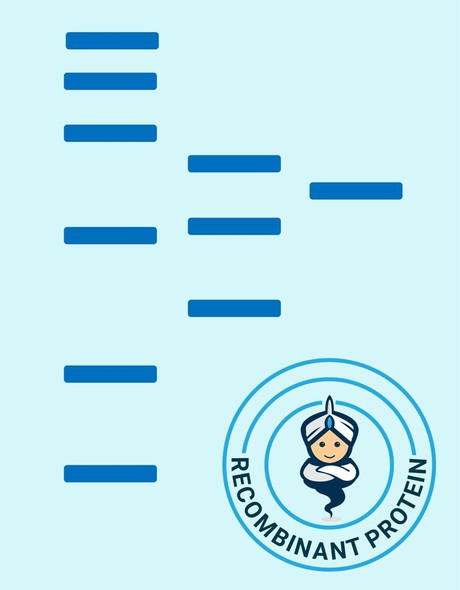Enzymes Recombinant Proteins
Human GLUL Recombinant Protein (RPPB5813)
- SKU:
- RPPB5813
- Product Type:
- Recombinant Protein
- Species:
- Human
- Uniprot:
- P15104
- Research Area:
- Enzymes
Description
| Product Name: | Human GLUL Recombinant Protein |
| Product Code: | RPPB5813 |
| Size: | 10µg |
| Species: | Human |
| Target: | GLUL |
| Synonyms: | Glutamine synthetase, GLUL Active, GLUL, Glutamine Synthetase, Active, GLNS, GS, PIG43, PIG59, Glutamate decarboxylase (EC:4.1.1.15), Glutamate--ammonia ligase. |
| Source: | Escherichia Coli |
| Physical Appearance: | Sterile filtered colorless solution. |
| Formulation: | GLUL protein solution (1mg/ml) containing 20mM Tris-HCl buffer (pH8.0), 10% glycerol 1mM DTT and 0.1mM PMSF. |
| Stability: | Store at 4°C if entire vial will be used within 2-4 weeks. Store, frozen at -20°C for longer periods of time. For long term storage it is recommended to add a carrier protein (0.1% HSA or BSA).Avoid multiple freeze-thaw cycles. |
| Purity: | Greater than 85.0% as determined by SDS-PAGE. |
| Amino Acid Sequence: | MTTSASSHLN KGIKQVYMSL PQGEKVQAMY IWIDGTGEGL RCKTRTLDSE PKCVEELPEW NFDGSSTLQS EGSNSDMYLV PAAMFRDPFR KDPNKLVLCE VFKYNRRPAE TNLRHTCKRI MDMVSNQHPW FGMEQEYTLM GTDGHPFGWP SNGFPGPQGP YYCGVGADRA YGRDIVEAHY RACLYAGVKI AGTNAEVMPA QWEFQIGPCE GISMGDHLWV ARFILHRVCE DFGVIATFDP KPIPGNWNGA GCHTNFSTKA MREENGLKYI EEAIEKLSKR HQYHIRAYDP KGGLDNARRL TGFHETSNIN DFSAGVANRS ASIRIPRTVG QEKKGYFEDR RPSANCDPFS VTEALIRTCL LNETGDEPFQ YKN |
| Biological Activity: | Specific activity is > 2.000 pmol/min/ug, and is defined as the amount of enzyme that convert L-glutamate to L-glutamine per miunte at pH 7.5 at 37C in coupled system with PK/LDH. |
GLUL catalyzes the synthesis of glutamine from glutamate and ammonia. Glutamine is a major source of energy and that takes part in cell proliferation, inhibition of apoptosis, and cell signaling. GLUL is expressed during early fetal stages, and has a role in maintaining body pH by removing ammonia from circulation. Mutations in GLUL gene are related with congenital glutamine deficiency.
GLUL Recombinant Human produced in E.Coli is a single, non-glycosylated polypeptide chain containing 373 amino acids (1-373) and having a molecular mass of 42kDa.
| UniProt Protein Function: | GLUL: This enzyme has 2 functions: it catalyzes the production of glutamine and 4-aminobutanoate (gamma-aminobutyric acid, GABA), the latter in a pyridoxal phosphate-independent manner. Essential for proliferation of fetal skin fibroblasts. Defects in GLUL are the cause of congenital systemic glutamine deficiency (CSGD). CSGD is a rare developmental disorder with severe brain malformation resulting in multi-organ failure and neonatal death. Glutamine is largely absent from affected patients serum, urine and cerebrospinal fluid. Belongs to the glutamine synthetase family. |
| UniProt Protein Details: | Protein type:Amino Acid Metabolism - alanine, aspartate and glutamate; Amino Acid Metabolism - arginine and proline; EC 6.3.1.2; Energy Metabolism - nitrogen; EC 4.1.1.15; Ligase Chromosomal Location of Human Ortholog: 1q31 Cellular Component: cytoplasm; cytosol; nucleus Molecular Function:glutamate-ammonia ligase activity; identical protein binding; protein binding Biological Process: amino acid biosynthetic process; cell proliferation; glutamate catabolic process; glutamine biosynthetic process; neurotransmitter uptake Disease: Glutamine Deficiency, Congenital |
| NCBI Summary: | The protein encoded by this gene belongs to the glutamine synthetase family. It catalyzes the synthesis of glutamine from glutamate and ammonia in an ATP-dependent reaction. This protein plays a role in ammonia and glutamate detoxification, acid-base homeostasis, cell signaling, and cell proliferation. Glutamine is an abundant amino acid, and is important to the biosynthesis of several amino acids, pyrimidines, and purines. Mutations in this gene are associated with congenital glutamine deficiency, and overexpression of this gene was observed in some primary liver cancer samples. There are six pseudogenes of this gene found on chromosomes 2, 5, 9, 11, and 12. Alternative splicing results in multiple transcript variants. [provided by RefSeq, Dec 2014] |
| UniProt Code: | P15104 |
| NCBI GenInfo Identifier: | 1169929 |
| NCBI Gene ID: | 2752 |
| NCBI Accession: | P15104.4 |
| UniProt Secondary Accession: | P15104,Q499Y9, Q5T9Z1, Q7Z3W4, Q8IZ17, |
| UniProt Related Accession: | P15104 |
| Molecular Weight: | 42,064 Da |
| NCBI Full Name: | Glutamine synthetase |
| NCBI Synonym Full Names: | glutamate-ammonia ligase |
| NCBI Official Symbol: | GLUL�� |
| NCBI Official Synonym Symbols: | GS; GLNS; PIG43; PIG59�� |
| NCBI Protein Information: | glutamine synthetase |
| UniProt Protein Name: | Glutamine synthetase |
| UniProt Synonym Protein Names: | Glutamate decarboxylase (EC:4.1.1.15); Glutamate--ammonia ligase |
| UniProt Gene Name: | GLUL�� |
| UniProt Entry Name: | GLNA_HUMAN |






